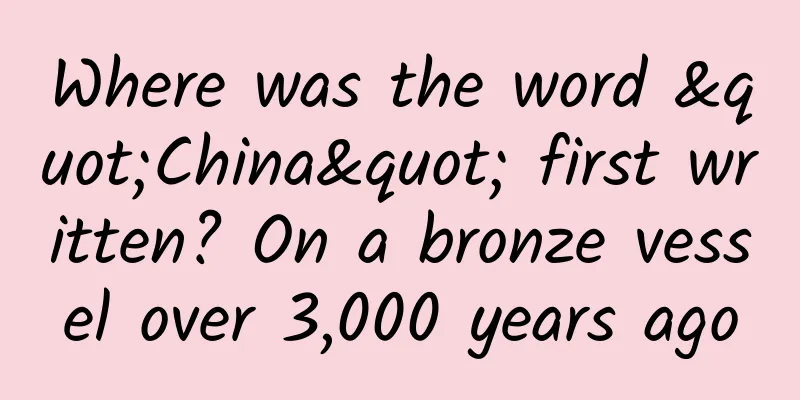Where was the word "China" first written? On a bronze vessel over 3,000 years ago

|
1. Civilization and Writing At the end of the barbaric era of ancient society, humans invented the technology of artificial copper smelting and copperware making. Driven by the replacement of Neolithic tools with copperware as the main or important production tools and living utensils, the level of social productivity gradually developed to enable humans to maintain a life of more than enough food and clothing, and then laid the material and economic foundation necessary for the civilized era that followed. Here, "more than enough" played a key role in the process of humans entering the civilized state. If the labor results of workers can ensure that their living standards are more than enough food and clothing, there is no need for all people to engage in labor to meet their basic needs, and then various handicraft labors will appear to meet the various needs of humans, forming a social division of labor. Social division of labor requires appropriate exchange of different types of labor results, so there are markets, commerce and trade activities; these activities often occur near fixed gatherings or residences of people, so some gatherings and residences in farming areas gradually expand and develop into cities. In order to facilitate frequent communication between a large number of people and the accumulation and dissemination of knowledge, and to further improve social productivity, it is necessary to transform the language into a unified systematic writing on a large scale. The continuous accumulation of "surplus" property also involves the issue of its distribution. People engaged in different labor usually have different social functions and status, which often leads to uneven distribution of property. The complexity of urban and social structures has created a need for management, and the emergence of disputes in society also requires management institutions with coercive power, namely the state and the army. The accumulation of surplus labor results of workers has provided a driving force for the dominant ethnic groups to get rich by plundering the labor results of other ethnic groups, and has also laid the foundation for enslaving people of other ethnic groups to seize their surplus labor capacity. The wars that emerged in Chinese society led to the integration and unification of ethnic groups [1-2], while wars between ethnic groups to plunder wealth and exploit slaves occurred in Western society; then, tools specifically used for fighting, namely copper weapons, appeared. Differences in social status and distribution of property, and even the formation of slavery, led to class divisions. The above are the various hallmarks of the civilized era. It can be seen that the civilized era is an era that presents the above-mentioned new social characteristics after the productivity of human society has reached a level of more than enough food and clothing driven by the widespread use of copper tools. Among them, the formation of systematic writing is one of the important signs of the beginning of the civilized era. The emergence and development of major civilizations in the world are accompanied by the continuous maturity and extensive application of writing. However, from the emergence of early civilizations around 3000 BC to the invention of papermaking in China in the early AD, there was no paper for recording text, and humans had to use other available materials to record text. In the Paleolithic Age, humans began to record some simple language information by carving simple traces on stone, bone, wood, and bamboo or tying knots on ropes. Then they gradually tried to carve graphics or symbols on various objects to express some language information that needed to be conveyed. These graphics or symbols are simplified pictures and symbols according to the objective image of the things to be expressed, and are the predecessors of pictograms. Language is just an instantaneous way of communication that leaves no physical traces. Only by recording language can information be transmitted to people living in different spaces and times in a concrete and visible form. In the Neolithic period, humans had accumulated a large amount of knowledge and experience in production and life that needed to be communicated or passed on to the next generation, and in many parts of the world, a large number of symbolic languages were used to transmit information and knowledge. When those carved graphic symbols were gradually simplified and standardized, multiple symbol links could express complex meanings, symbols were combined with fixed language pronunciations, and systematic symbols were accepted and used by a larger population, they gradually evolved into universal writing. Writing is a systematic symbol system that preserves and transmits language information, allowing information to be transmitted on a large scale and efficiently over a wide range of time and space [1-2]. 2. Early writing in the Mediterranean region and its supporting materials Around 3200 BC, the Sumerian civilization, which used cuneiform writing to record a large number of items, emerged in Mesopotamia in Western Asia[3]. Figure 1(a) [Knowledge Tips] shows cuneiform writing from around 3000 BC that represents various copper objects such as copper knives, copper drills, and copper containers[4]. Cuneiform is one of the earliest characters in the world that can be deciphered today. It was originally pictographic, but later gradually changed into a non-pictographic and more complex writing system[5]. Cuneiform writing is mostly written on clay tablets and also carved on stones[6]. Among the approximately 5,000 clay tablets unearthed from the earliest cuneiform period of Sumer's Uruk IV-III period between 3200 and 2900 BC, 85% of the tablets describe social and economic events at the time[7]. This not only shows that the social and economic level is the core foundation for entering the civilized era, but also confirms the important role of copper objects and writing in economic development. From about 3200 to 3100 BC, the ancient Egyptian civilization with a large number of hieroglyphs (Figure 1(b)) appeared in the Nile region of Egypt. It is also one of the earliest characters in the world that can be deciphered today. This kind of writing is mostly engraved on stone, clay tablets, pottery, bone pieces, and ivory[8]. From about 2500 to 2400 BC, a large number of Harappan seal characters (Figure 1(c)) that have not been deciphered so far appeared in the ancient Indian region[9]. The seal characters used animals or other objects and lines to form independent seal patterns. These seal patterns were also mostly engraved on stone or clay tablets[10]. Figure 1 Writings of ancient civilizations in the Middle East: (a) Cuneiform writing describing various bronze artifacts in Sumer, Mesopotamia, around 3000 BC [4]; (b) Hieroglyphics found in the tomb of Nefertari, the queen of the ancient Egyptian pharaoh Ramses II, in 1255 BC [1]; (c) Seal writing of ancient Indian civilization that has not yet been deciphered [9] Around 1500 BC, the Mycenaean civilization had emerged in the Aegean region, and a roughly decipherable Mycenaean script was formed[11], called Linear B. This is a type of pictographic script (Figure 2(a))[1-2], recorded on clay tablets or pottery[11]. The number of copies is limited, and the content is simple account data. At the same time, the Phoenicians living in today's Syria, under the influence of Sumerian and ancient Egyptian civilizations, simplified the cuneiform script with the help of the graphics of ancient Egyptian pictographic scripts, and thus refined and created the Phoenician phonetic script consisting of 22 letters[12]. Around 850 to 750 BC, the Greeks in the Aegean region used the 22 Phoenician letters as a basis, added a few self-created letters, and created the Greek alphabet that is still in use today[13]. Figure 2(b) shows the process of the Greek alphabet being transformed from the Phoenician alphabet over time (from left to right). The three columns of letters on the left side of the blank area in the middle of Figure 2(b) represent the changes of these Phoenician letters over time; the leftmost column of the three columns of letters on the right side of the blank area in the middle of Figure 2(b) represents the appearance of the Greek alphabet when it was first borrowed from the Phoenician alphabet, and the two columns on the right represent the changes of these Greek letters over time; the two columns on the far right of Figure 2(b) are the finalized Greek alphabet and its pronunciation[13]. A line of poetry written in Greek letters first appeared on pottery between 750 and 700 BC[14]. The Greek alphabet subsequently gave rise to the Latin alphabet and the Cyrillic alphabet created by the Romans, and became the origin of various Western phonetic alphabets and scripts. Therefore, British historian Wells believed[15] that all the phonetic alphabets produced in the world later evolved from a mixture of cuneiform and ancient Egyptian hieroglyphics, including the official languages of the United Nations such as English, French, Spanish, and Russian, as well as the languages of other European languages such as German, Italian, etc. Figure 2 Writing in ancient Greece: (a) Mycenaean Linear B on clay tablets [Greek] [1]; (b) Greek alphabet based on the transformation and evolution of the Phoenician alphabet [2,13] The oldest ancient southern Arabic script appeared on a stele around 900 BC (Figure 3)[2]. Around 750 BC, the ancient Arab tribes in Yemen created their own script under the influence of the Phoenician script[16]. In southern Egypt, written documents influenced by the Phoenician language were also discovered in the 6th century BC[17]. These early Arabic languages and other scripts derived from the Phoenician script underwent very complex combinations and evolutions, forming the current standard Arabic script around 500 AD[18]. Figure 3 Ancient Arabic southern script tombstone from around 900 BC [Sha][2] 3. The origin of Chinese characters and their carrier materials During the formation of Chinese civilization, the development of Chinese characters went through a long process of emergence and evolution. The earliest Chinese tortoise shell with characters carved on it dating back to around 6000 BC was unearthed in Jiahu, Wuyang, Henan (Figure 4(a)). The enlarged part of the tortoise shell slightly to the lower right side is shown in Figure 4(b)[19]. After the Neolithic period, from around 5500 to 2700 BC, written or carved characters on pottery were found all over China (Figure 5). A stone axe with characters carved on it dating back to around 3000 BC was also unearthed at the Zhuangqiao Tomb Site in Pinghu, Zhejiang[20]. Figure 4 Chinese characters on oracle bones: (a) Jiahu tortoise shell from Wuyang, Henan Province, about 6000 BC [豫]; (b) characters on the lower right side of the Jiahu tortoise shell; (c) oracle bone script written on bone plates in ancient China during the Shang Dynasty [国] Figure 5 Characters on pottery fragments found in various places in Chinese history [1-2]: (a) Dadiwan, Qin'an, Gansu, about 5500 BC [Gan]; (b) Liulinxi, Yidu, Hubei, about 5000 BC [E]; (c) Banpo site, Xi'an, Shaanxi, about 4500 BC [Ban]; (d) Dawenkou area, Tai'an, Shandong, about 3400 BC [Guo]; (e) Liuwan, Qinghai, about 2700 BC [E] After years of archaeological research, many carved characters that appeared in China's Neolithic period have been identified as the prototypes of early Chinese characters and have been deciphered. For example, the connection between the Jiahu characters in Wuyang, Henan Province, about 6000 BC [19] and modern Chinese characters has been discovered (Figure 6 (a)). Another example is that a large number of characters on pottery fragments from the Shuangdun site in Bengbu, Anhui Province, about 5300 BC, have been deciphered with the help of oracle bone inscriptions and modern Chinese characters (Figure 6 (b)). These archaeological excavations and studies show that Chinese characters appeared in the Neolithic period and gradually formed a system. Many characters in the late Neolithic period evolved into today's Chinese characters. Therefore, the development and systematization of Chinese writing symbols in the Neolithic period is the main basis for the subsequent development and evolution of oracle bone inscriptions and modern writing. These characters on Neolithic pottery fragments are called pottery characters [21]. Archaeological excavations have found that many pottery pieces are engraved with a variety of writing symbols evolved from the Neolithic period [22], and many of the characters are close to the characters of the early Shang Dynasty. Figure 6 Characters that appeared in the Neolithic period and can be interpreted today and have evolved into today’s Chinese characters [1-2] By the late Shang Dynasty, Chinese characters had become very mature, with a wealth of Chinese characters left on tortoise shells, animal bones, pottery, jade, and bronze artifacts, covering all aspects of social life, including agriculture, animal husbandry, handicrafts, politics, military affairs, commerce, medicine, calendar, punishment, and sacrifice. The earliest systematic official Chinese characters discovered in China are oracle bone inscriptions (Figure 4(c)). Given the extremely popular and developed copper smelting and copper-making technology during the Shang and Zhou dynasties[2], Chinese characters were also widely displayed on bronze products of the time in the form of inscriptions, mostly with the help of casting technology[23]. According to archaeological statistics[24], about 6,000 bronze artifacts with inscriptions have been discovered from the Shang Dynasty. By the Western Zhou Dynasty, the longest inscription on the "Mao Gong Ding" reached 499 characters[25]. The earliest word "China" appeared in the inscription on the bronze artifact "He Zun" in the early Western Zhou Dynasty around 1000 BC[26]. Take the bronze vessel “Da Yu Ding” (Figure 7(a)) from the early Western Zhou Dynasty, which dates back to around 1000 BC. The height of the tripod is 101.9 cm, the diameter is 77.8 cm, and the weight is 153.5 kg. The inner wall of the tripod is cast with a long inscription, which contains 19 lines and 291 characters (Figure 7(b)). It records the event in which King Kang of Zhou appointed his minister “Yu” in September of the 23rd year of his reign (1003 BC). In the inscription, King Kang of Zhou recounted the founding experiences of King Wen and King Wu, and summarized the historical lesson that the Shang Dynasty was destroyed due to alcoholism. He recounted the long-term training that “Yu” had received in the Zhou Dynasty, and warned “Yu” to emulate his ancestors, be diligent and dedicated to the public, and perform his duties conscientiously. He appointed “Yu” to inherit his grandfather’s official position, be in charge of the army, be responsible for litigation, and assist the King of Zhou in governing the world. He also rewarded “Yu” with clothing, carriages, subordinate officials, and servants. Finally, “Yu” praised the virtues of King Kang of Zhou [27]. Figure 7 Dayu Ding (Guo) from the early Western Zhou Dynasty: (a) the body of the tripod; (b) the inscription on the inner wall 4. The world's major writing systems At present, there are many different scripts in use around the world. Some of these scripts correspond to languages that are the mother tongues of a very large population. A language is used as a mother tongue by many people. Based on the population corresponding to each mother tongue, the six languages with the largest user scale can be ranked, namely English, French, Spanish, Russian, Arabic, and Chinese. Therefore, these six languages are also the working languages of the United Nations. The scripts corresponding to these six languages are English, French, Spanish, Russian, Arabic, and Chinese. According to the above description, among the six working languages of the United Nations, the phonetic scripts of five languages, namely English, French, Spanish, Russian, and Arabic, are indirectly derived from the Phoenician script in different forms; only the Chinese script is an independently developed hieroglyphic system that has nothing to do with the Phoenician script. Figure 8 briefly summarizes the rise and fall of these six scripts and their mutual connections [2]; the first five scripts have a certain internal connection because they borrowed from the Phoenician script to varying degrees, and therefore all involve the early Sumerian cuneiform script and the ancient Egyptian hieroglyphics. Figure 8 The rise and fall of major writing systems around the world and their connections between 4000 BC and 1000 AD [2] (Dark areas: mature and prosperous writing systems; light areas: emerging or declining writing systems) The pronunciation of phonetic characters corresponds to spoken language, and a corresponding writing system can be developed based on the pronunciation habits of a local language. In the early days of human civilization, the movement and communication between major ethnic groups was not widespread, and the geographical isolation between regions made it easy for people living in different regions for a long time to develop their own dialect pronunciation systems and form their own unique characters corresponding to the pronunciation. Therefore, in different regions of a large geographical range that use phonetic characters, it is easy to derive different characters based on their dialects, and each has its own characteristics; just like the distribution of various languages and characters in Europe, which all use phonetic characters today. On the contrary, for pictographic writing like Chinese characters, the meaning of the characters is separated from their pronunciation. After Qin Shihuang unified the writing system, Chinese characters have always remained unified. Therefore, although there are various local languages in China that are difficult to understand each other, the written characters are the same; the characters written in one place can be easily understood in any other place in China without translation. The large number of Chinese characters preserved on bronze vessels has also greatly promoted the widespread and long-term dissemination of Chinese culture, becoming the language used as the mother tongue of the largest number of people in the world today. The unified feature of Chinese characters as pictographic writing has played a positive role in promoting the Chinese civilization to maintain the tradition of integration and unity. 5. Conclusion Driven by the artificial copper smelting technology, the productivity level was raised to a standard of living that was sufficient to ensure food and clothing. After that, human societies in various places entered the civilized era, showing the characteristics of various civilized eras; including civilizations around the world creating their own writing systems. These early characters were often pictographic and had recorded the bronze ware of the time. Before the popularization and application of papermaking, they were written or carved on clay tablets, stones, pottery, and various materials that could be carved and preserved, such as wood, bamboo, bones, tortoise shells, and ivory. The ancient characters preserved on various materials have conveyed a lot of information about the history of civilization to today's human beings. Among the six most widely used official languages of the United Nations, five languages based on phonetic writing characteristics, including English, French, Spanish, Russian, and Arabic, are all related to the phonetic writing created by the early Phoenicians in West Asia; only Chinese has nothing to do with it and still retains the characteristics of pictographic writing. Due to the extremely popular and developed copper smelting and copper making technology in early China, Chinese characters were also cast on copper vessels on a large scale, which greatly promoted the inheritance and prosperity of Chinese civilization. Unified Chinese characters are also conducive to the Chinese civilization to maintain the tradition of integration and unity. Acknowledgements: We would like to thank Professor Gong Yushu from the School of Foreign Languages at Peking University for his introduction and guidance on Sumerian writing. Knowledge Tips Some of the real photos in Figures 1 to 7 are from: Montreal Museum of Archaeology and History, Canada [Canada], National Archaeological Museum of Greece [Greece], National Museum of Saudi Arabia Unearthed Cultural Relics Exhibition [Saudi Arabia], Henan Museum [Yu], National Museum of China [China], Gansu Provincial Museum [Gansu], Hubei Provincial Museum [Hubei], Xi'an Banpo Museum [Banpo], Anhui Museum [Anhui]. References [1] Mao Weimin. Civilization and Materials: Exploring the Differences between Chinese and Western Civilizations from the Perspective of Materials Science. Beijing: China Social Sciences Press, 2022 [2] Mao Weimin. Materials and Civilization. Beijing: Higher Education Press, 2019 [3] Gong Yushu. Myths and legends on the origin of writing in the ancient Mesopotamian region. World History, 2007(2):103 DOI: 10.3969/j.issn.1002-011X.2007.02.011 [4] Englund RK, Nissen H J. Die Lexikalischen Listen der archaischen Texte aus Uruk. Berlin: Gebr Mann Verlag, 1993 [5] Fang Long. The Story of Humankind. Translated by Liu Mei. Beijing: China Friendship Publishing House, 2015 [6] Zhang Fanxi. On the beauty of the compositional form of cuneiform. Art Research, 2017(4):22 DOI: 10.3969/j.issn.1673-0321.2017.04.010 [7] Gong Yushu. The Sun Rises in the East: Exploring the Mystery of Sumerian Civilization. Kunming: Yunnan People's Publishing House, 2001 [8] Zhang Ye. A brief discussion on ancient Egyptian hieroglyphics. Arab World, 2000(4):45 [9] Ding Zhou. Always mention Greece or China: Volume 1. Beijing: Beijing Daily Press, 2015. [10] Chen Zidan. The epigraphic archives of ancient India. Archives, 2000(1):30 [11] Lu Huibin. Interpreting Linear B in Chinese. Journal of Jiangxi Science & Technology Normal University, 2010(4):47 [12] Van Loon H W. The Story of Mankind. Radford: Wilder Publications, 2008 [13] Niels J. Reading Ancient Greece at the British Museum. Shanghai: Shanghai Jiaotong University Press, 2013 [14] Murray O. Early Greece. 2nd Ed. London: Harper Collins Publishers, 1993 [15] Wells, H. G. The Story of Civilization. Translated by Gao Yao. Xi’an: Shaanxi Normal University Press, 2009 [16] Liu Kaigu. A brief discussion on the origin of Arabic. Arab World, 1987(4):9 [17] Lu Peiyong. Ancient Syriac and its relationship with Arab-Islamic civilization. Arab World, 1998(2):148 [18] Wang Chenglong. The origin of Arabic script. Arab World, 1986(1):136 [19] Feng Ping, Wu Changqi. A preliminary study on the inscriptions on tortoise shells from Wuyang. Zhongyuan Cultural Relics, 2009(3):51. DOI: 10.3969/j.issn.1003-1731.2009.03.009 [20] Mysterious symbols on the stone axe. Wenzhou Business Daily, 2013-7-10 [21] Li Xingbin. The culmination of Tao Wen’s works. National New Book List, 2007(7):6 [22] Guo Yong. History of Xia. Shanghai: Shanghai People’s Publishing House, 2015 [23] Wu Jingxia. The production technology of bronze inscriptions of the Shang and Zhou dynasties and the reproduction of the Song Ding of the Western Zhou dynasty. Cultural Relics Protection and Archaeological Science, 2008, 20(4): 55 DOI: 10.3969/j.issn.1005-1538.2008.04.009 [24] Miao Lijuan. Overview of Shang Dynasty inscribed bronze vessels unearthed across China. Journal of Yindu University, 2009(3):28 [25] Lian Xiuli. Inscriptions of the Western and Eastern Zhou Dynasties and the Origin of Ancient Chinese Writing Style. Qilu Journal, 2019(6):118 DOI: 10.3969/j.issn.1001-022X.2019.06.017 [26] He Zhenpeng. “China” in the inscription on the He Zun. Cultural and Museum Studies, 2011(6):32 DOI: 10.3969/j.issn.1000-7954.2011.06.005 [27] Lv Weitao. The past and present of Dayu Ding. Collection, 2021(9):88 About the author: Mao Weimin (1950-), male, retired teacher of University of Science and Technology Beijing, guest writer of Metal World. He has conducted research on basic principles and application technologies of materials for a long time, and is currently engaged in the observation and analysis of the intrinsic relationship between the progress of materials technology and the development of human society. He has written Materials and Civilization, Civilization and Matter: Exploring the Differences between Chinese and Western Civilizations from the Perspective of Materials Science, etc. |
<<: What? Your brain will freeze? Be careful when eating this kind of food!
Recommend
How to promote APP on campus by doing activities
1. There are three common activities: booth activ...
Solution sharing | Internet home improvement brand planning and marketing promotion suggestions!
Competition is fierce in the new media marketing ...
Please save these tips for achieving mobile app user growth!
When traffic and users in various industries are ...
Beautiful summer vacation, fresh food
Author: Li Haijie, School of Public Health, North...
Webb telescope: The mind-boggling details of its $10 billion construction
Seeing the first batch of color photos released b...
Platform-based brand marketing strategy!
There are huge differences in brand marketing bet...
How to make a good online event promotion plan?
In marketing psychology, herd mentality, greed fo...
Weisou v2.0.1 Multi-function search engine for pictures, network disks, etc._Free mobile software, download software
Software Information Name: Weisou Package name: c...
WM Motor EX5 caught fire in Wenzhou: The whole vehicle burned but no one was injured
[NetEase Intelligence News, September 23] Today, ...
Android Studio 1.0.1 + Genymotion Android emulator creates an efficient Android development environment
We mostly develop Android using Eclipse and the A...
XGIMI Z4 Aurora Screenless TV Review: A versatile TV for both commercial and residential use
12.12, Saturday. Double 12 falls on the weekend, ...
The hot 2022 Chengdu new tea arrangement is worth collecting
Reservation arrangements for Chengdu new tea: 135...
Using "disposable shower cap" to cover dishes, is this kind of plastic wrap really usable?
In our home life, we use plastic wrap almost ever...
The closest black hole to the solar system has been discovered, and it is only 1,000 light-years away from us!
[Mobile software: Bo Ke Yuan] A team of astronome...









